Each and every Indian wedding is one-of-a-kind. A Bengali wedding, also known as a ‘Biye,’ is a sight to behold.
The wedding ceremony is performed in accordance with traditional Hindu rites. The bride and groom exchange garlands, known as ‘Mala’, to symbolize the start of the union. Afterward, the families perform a sacred fire ceremony called ‘Agni-Puja’ where they offer prayers for a successful marriage. The bride wears a pink or red sari, which is considered to be a symbol of purity and joy. The groom wears a traditional Bengali dhoti, signifying his readiness to take on the role of husband.
A plethora of deep, significant rituals steeped in culture and tradition are carried out among a swirl of colourful exquisite and wildly inventive decorations at a typical wedding in Bengal.
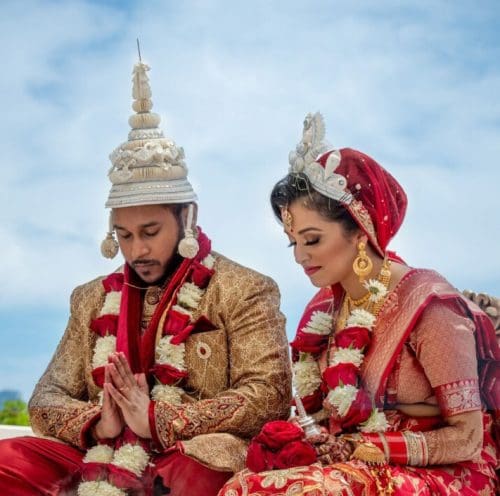
Pre-Wedding Rituals in a Bengali wedding
- Paka Katha or Pati Potro- Elder members of the groom’s and bride’s families gather together for a formal agreement regarding various aspects of the marriage. The Ghotis refer to it as Paka Dekha, whereas the Bengali refers to it as Pati Potro.
- Aiburobhat– This is a type of bridal shower that occurs in the afternoon or evening before the typical Bengali wedding day. In most cases, the bride’s closest friends and relatives assemble at her home to shower her with presents. Then she is served a lavish meal of rice, fish, and a variety of vegetable dishes. As a spinster, this is believed to be her final meal. At the groom’s house, where he eats his last meal as a bachelor, the same tradition is practised.
- Gaye Holud and Tattwa–The groom’s mother and other married female relatives apply a turmeric paste made by grinding fresh turmeric with mustard oil to his body. He is subsequently bathed in the water he received earlier in the day. The remaining turmeric paste is placed in a silver basin and delivered to the bride’s residence together with her whole trousseau, including a basic attire to wear during the Gaye Holud and a whole Rohu fish.
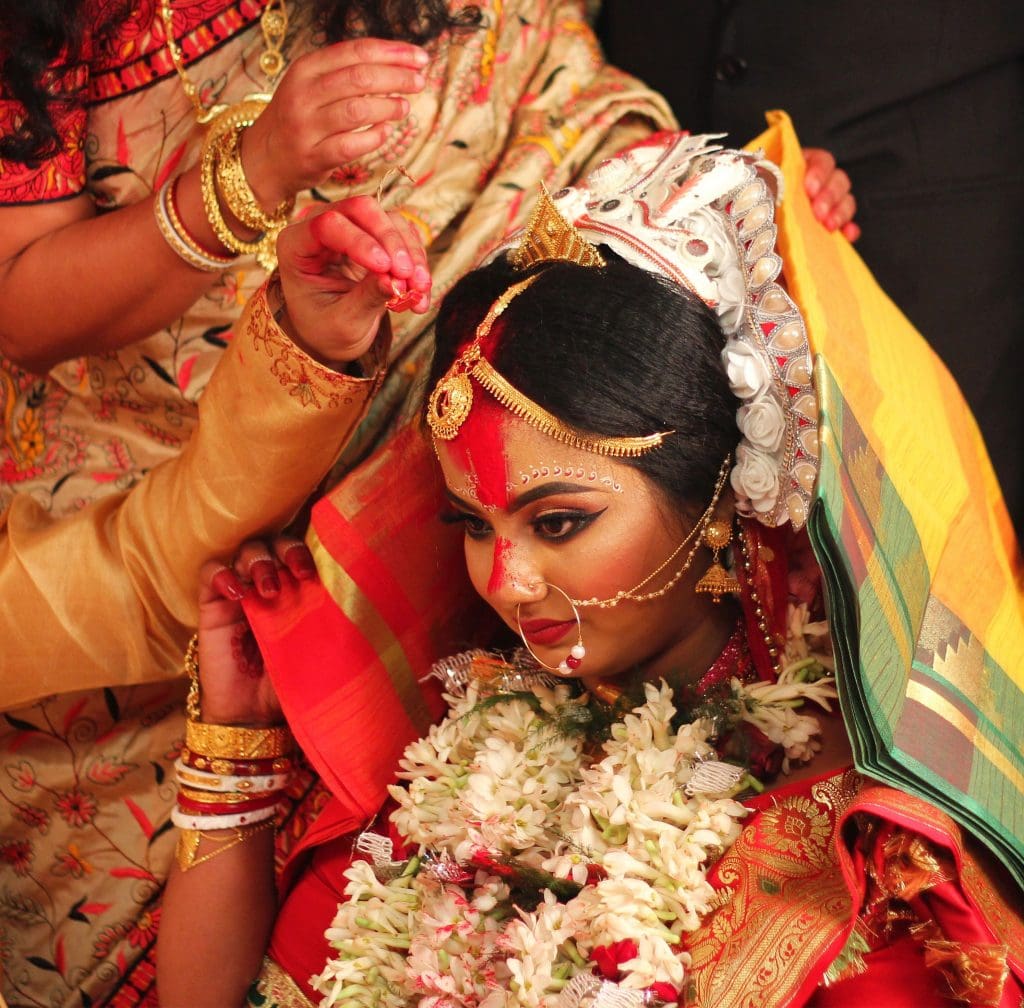
- Bor Jatri and Boron–After getting his mother’s blessings, the groom departs from his home in a specially decorated car supplied by the bride’s family, followed by a handful of his acquaintances and elderly male relatives, for the wedding destination. Bor Jatri refers to the people who accompany the groom or Bor. The Groom and the Bor Jatri are greeted with great enthusiasm when they arrive at the wedding place, with conch shells being blown and ululations being sung. The bride’s mother greets him with a Baran Dala, a big cane tray filled with auspicious elements such as rice, turmeric, betel nuts, a bunch of bananas, and a lit diya. She places it on the groom’s forehead, shoulders, and chest three times, then repeats the process.
- Ashirbaad– The bride’s elders take rounds blessing the husband and bestowing lavish presents like as jewellery, cash, or even watches on him. The elders who accompany the groom and the bride go through the same ceremony, blessing her and presenting her with jewellery.
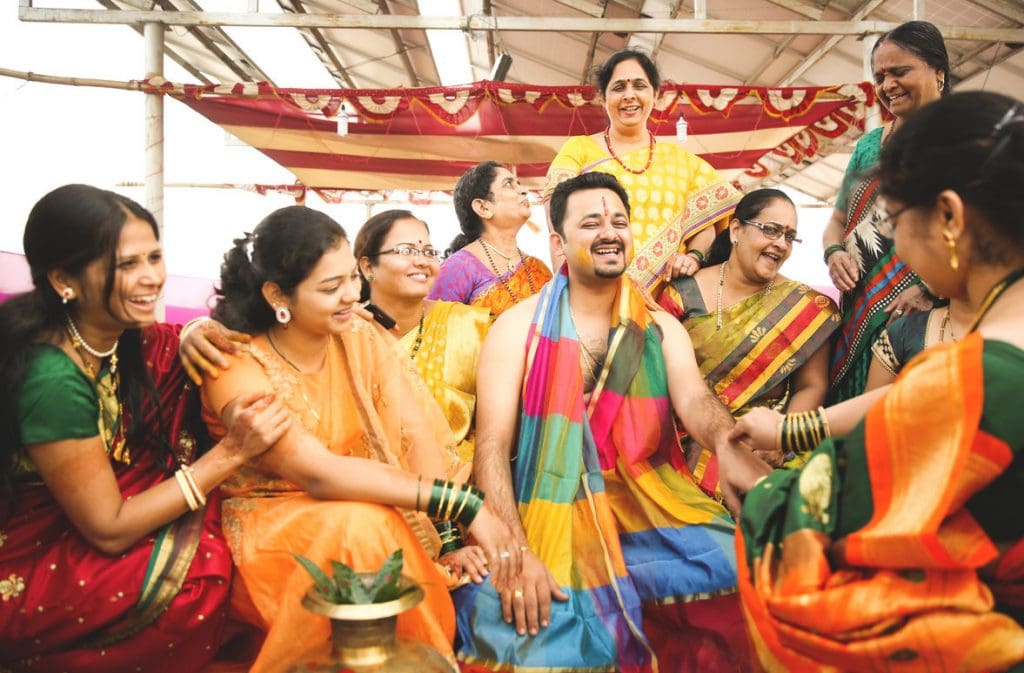
- Saat Paak and Subho Drishti–Saat Paak occurs immediately after the bride is taken to the wedding mandap while wearing two betel leaves over her face. Typically, the groom’s brothers or relatives carry her in a Peerhi or wooden seat, and they make seven circles around him. On Shubho Drishti, the bride and husband stare at each other three times after this Saat Paak is completed.
- Mala Badal– The couple then exchanges their garlands in the Mala Bodol ceremony. When the bride’s and groom’s relatives hoist them up to make them difficult to reach, it adds a humorous touch. There is a lot of competitive fun and laughs.
- Kanya Sampradan– The bride is then taken into the Chhadnatolla, sits opposite the groom, and an elderly male member of the bride’s family joins their hands and binds them with the sacred thread, while the priest repeats the mantras that formally give the bride away to the groom.
- Saptapadi– The priest weaves a knot at the end of the bride’s saree and the groom’s shawl in Saptapadi. The pair must then go seven times around the fire while saying the seven sacred vows.
- Lajanjali/Kusumdinge– The bride’s brother places puffed rice in her palms, the groom links her hands behind her, and the two of them pour the offering into the fire together. The husband then applies Sindoor to the parting of the bride’s hair and drapes a new saree, known as the Lajjabastra, over her head.
Post-Wedding Rituals – Bengali wedding traditions
- Bidaai– Bidaai refers to the couple’s departure from the bride’s home. It is mostly a tear-jerking and emotional occasion. The bride tosses a handful of rice over her shoulder into the outstretched palms of her mother. The couple departs before dusk.
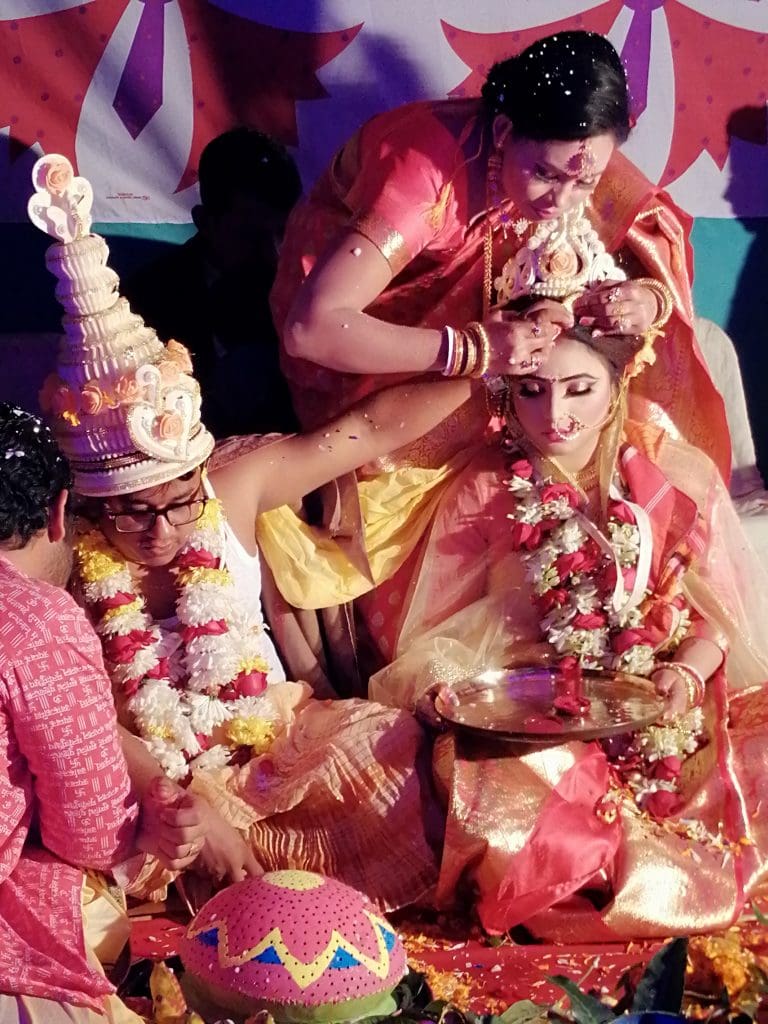
Webgurusam)- Bodhu Baran – The bride is welcomed into her in-laws’ home in Bodhu Baran. Water is poured underneath the vehicle, and a jug containing milk and lac dye is set outside the door for the bride to step into, leaving an imprint on the white fabric. The elders of the house then bless her with cash and jewellery as gifts.
- Kaal Ratri – On the night the bride arrives at her husband’s home, the pair are not permitted to mingle and is placed in separate rooms.
- Bou Bhaat – The bride is officially welcomed into the new family the next morning during the Bou Bhaat ritual. On a plate, the husband gifts his wife with clothes and sweets, promising to look after her for the remainder of their life. She then serves rice and ghee to the family members at supper.
- Reception — That evening, the groom’s family hosts a reception for their relatives, where they can meet the new bride and send their best wishes.
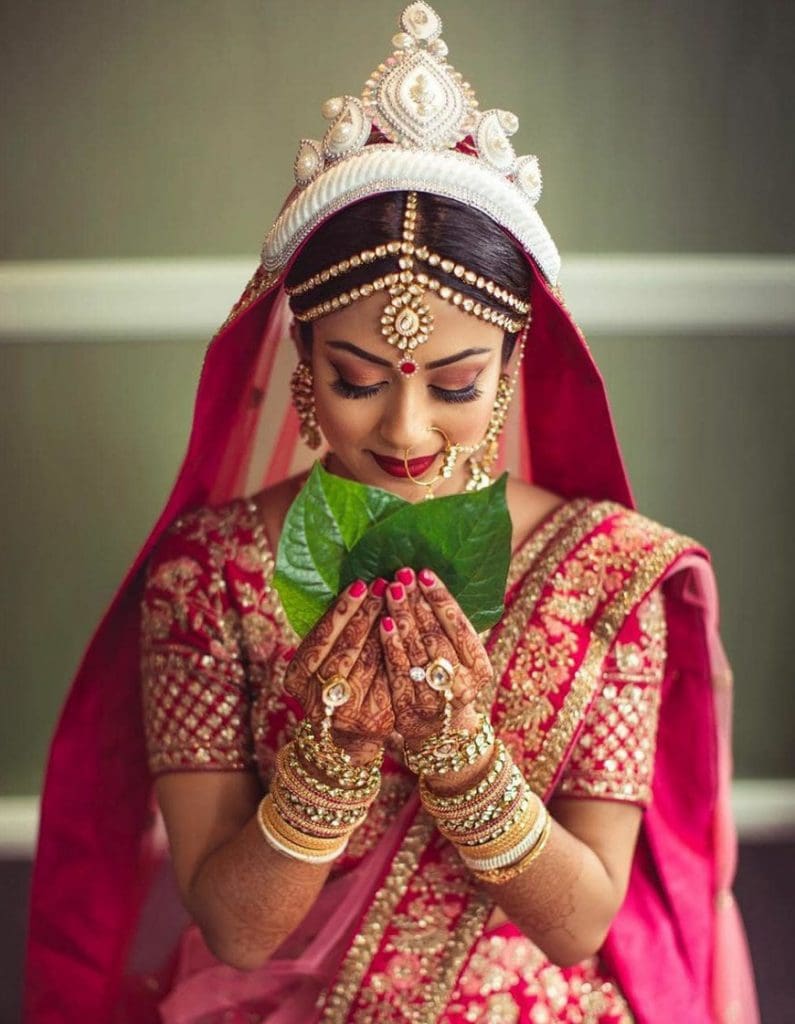
Wedding Attires in Bengal
Bengali wedding dresses are regal for both bride and groom. The Bengali groom usually wears a Dhoti and a Kurta, also known as Panjabi. While the Panjabi can be made of a variety of fabrics such as cotton, silk, or tussar, the Dhoti is usually made of Muslin or Tant, a Bengal handloom. The Panjabi is embellished with gold or diamond-studded buttons.
On the groom’s forehead, there are spots of sandalwood paste. He also wears a conical head ornament fashioned of Shola or Indian Cork known as the ‘Topor.’ He also has tuberose and rose garlands around his neck. He is to change into a beautiful silk two-piece dress known as the ‘Jor’ when he attends the wedding. The groom is required to carry the ‘Darpan,’ a spherical brass device with a long handle, at all times.
The Bengali bride’s dress is one of the most regal and gorgeous, turning her into a Goddess. She usually wears a red Benarasi saree adorned with gold zari threads and made of silk. The ‘aath poure’ style is historically Bengali, however, it can be draped in a variety of ways.
She covers her head with a veil and adorns herself with a plethora of jewellery. The distinctive decorations made on the bride’s forehead with kumkum and sandalwood paste, focusing on that enormous red bindi, exemplify the quintessential Bengali aesthetic sensibility.
She must also wear a complimentary headdress, called Mukut, to the groom’s topor. The Bengali bride must carry an elegant wooden jar filled with sindoor as well as the ‘Gachh Kouto,’ a one-rupee currency. She must also carry a ‘Kajal Lata,’ an oblong or eye-shaped flat metallic container containing Kohl, according to some customs.
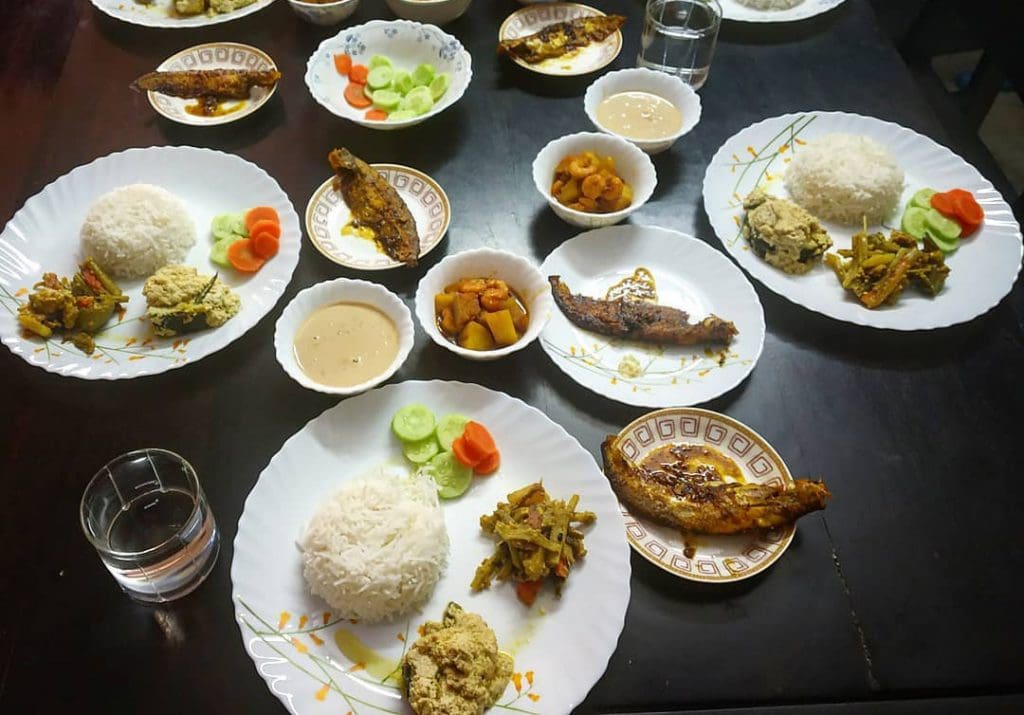
Wedding Food in Bengal
Fish Fingers
From the first bite, these delectable fish fingers will captivate your heart. It’s made with white fish that’s been diced into bite-sized fillets. These fillets are marinated in a flavorful spice blend before being deep-fried for a crispy outside and juicy interior.
Chingri Macher Malai Curry
Also called as Chingri Malai Curry, this dish combines curry spices with prawns and coconut milk to create a delightful and flavorful dish. It is an essential component of a traditional Bengali wedding dinner.
Begun Bhaja
This dish is high in potassium, fibre, and Vitamin C and is made with eggplants or brinjal. Chopped eggplant slices are marinated in a spice combination and deep/shallow fried. This dish goes well with rice or roti.
Mangshor Jhol
This is a traditional Bengali mutton curry made with large pieces of mutton and potatoes in a spicy, fragrant sauce. It is ideally served with a plate of steaming basmati rice and is a favourite of every Bengali home and mutton enthusiast.
Muger Dal
Muger is a lentil-based delicacy similar to moong dal, which is a staple of Bengali holidays.
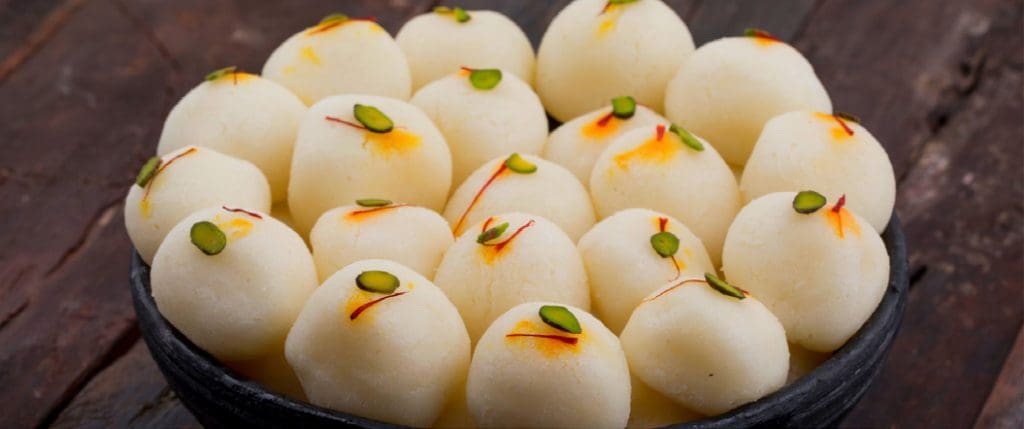
Rice
Bengalis are crazy about their rice! It’s no surprise, then, that long-grain basmati rice is a staple of every meal, large or small.
Rosogolla
No Bengali wedding is complete without a mention of the wet and spongy rosogolla. There are two types of rosogolla on the market: plain white rosogolla and jaggery (gurer) infused rosogolla.
Read More: Latest



